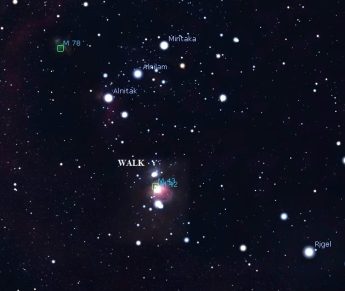This Week’s Sky at a Glance, 2024 Feb. 10 – Feb. 17
This Week’s Sky at a Glance, 2024 Feb. 10 – Feb. 17
Binoculars are great instruments for observing the brighter star clusters and nebulae in the night sky, and Orion is a great place for binocular treasures. Its most prominent naked eye feature is the angled line of three stars that make Orion’s Belt. This trio, part of a star cluster called Collinder 70, will fit easily within almost any binocular view. They are hot giant stars with the one on the right, Mintaka, being a little dimmer than Alnitak on the left and Alnilam in between. Although they appear to be near each other, at a distance of 2000 light years Alnilam is nearly twice as far as the other two. Between Alnilam and Mintaka binoculars will show an S-shaped asterism, Orion’s S, which peaks above his belt.
Below the belt is a string of a few dimmer stars that makes Orion’s sword, one of which looks fuzzy to the eye. Binoculars reveal this to be the Orion Nebula or M42, a vast cloud of gas and dust where stars are forming. Just above the nebula is an asterism that resembles a person running or perhaps the figure in a WALK sign. Several double or multiple stars can be seen in this general area. Binoculars will also enhance star colours so check out Orion’s two brightest stars, blue-white Rigel and orange Betelgeuse. Defocussing your binoculars slightly will enhance the colours even more.
This Week in the Solar System
Saturday’s sunrise in Moncton is at 7:30 and sunset will occur at 5:37, giving 10 hours, 7 minutes of daylight (7:33 and 5:43 in Saint John). Next Saturday the Sun will rise at 7:19 and set at 5:47, giving 10 hours, 28 minutes of daylight (7:23 and 5:53 in Saint John).
The slim crescent Moon is at perigee this Saturday, creating extreme tidal ranges over the weekend. It passes below Saturn that evening, near Jupiter on Wednesday, Uranus on Thursday and the Pleiades next Friday. Saturn is getting lost in twilight, heading toward conjunction at the end of February. Telescope users might see Jupiter’s Red Spot for two hours centred on 7 pm Monday, and later see its moon Io be occulted around 10:51. Mars will be a difficult target rising an hour before sunrise this week and half an hour after Venus. Mercury is lost in morning twilight, meeting up with Saturn in conjunction near the end of the month.
The Saint John Astronomy Club meets in the Rockwood Park Interpretation Centre on this Saturday at 7 pm, and the Fredericton Astronomy Club meets in the UNB Forestry-Earth Sciences building on Tuesday at 7 pm. On Sunday evening at 8 pm, tune in to the Sunday Night Astronomy Show via the Facebook page or YouTube channel of Astronomy by the Bay.

